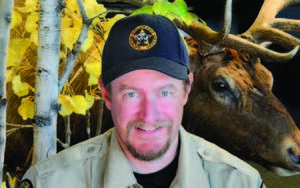Editorís note: This is a new monthly column from Colorado Parks and Wildlife focused on wildlife issues in the northeast part of the county, including Falcon, Black Forest, Peyton and Calhan.
The name of my column says it all ó I believe wildlife matters. I always have since I was a child. And that passion led me to my career as your local district wildlife manager, or DWM, for Colorado Parks and Wildlife.For CPW, I cover the wild side of Northeast El Paso County, including Black Forest, Falcon, Peyton and Calhan. I also cover some of Elbert County, north of U.S. Highway 24 and south of State Highway 86, including the towns of Elbert, Kiowa, Ramah, Simla, Matheson and a small portion of the Limon area.Iíve been a wildlife officer for more than seven years. For my first five years, I was stationed in the Kit Carson County area, and recently moved into my current position in 2018.†About my title, in Colorado we are called DWMs instead of the old fashioned ìgame wardenî label because we do so much more than just law enforcement. We are all biologists, and we spend much time doing educational programs and working closely with CPWís aquatic and wildlife biologists to manage wildlife populations.A little bit about me. I grew up on the south side of Denver. I spent most of my summers camping and fishing. In the fall and winters, I would be out in the wilds of Colorado hunting. I enjoyed my time in the outdoors and knew from an early age that I wanted to have a part in conserving Coloradoís wildlife and their habitats.So I focused my education to reach that goal. I received my Bachelorís in Wildlife Resources Management from Colorado State University in Fort Collins. While completing my degree; and, for a short time after, I worked as a seasonal park ranger for the Larimer County Department of Natural Resources at Horsetooth Reservoir.After a temporary stint with CPW in the Hunter Education Department, I was hired as a full-time DWM in January 2013. During my first year, I went through Police Officer Standards and Training (POST) and then spent the rest of the year going through various wildlife-based training.Often I am asked, ìWhat does a typical day look like for a district wildlife manager?î Truth is, there is no typical day, which makes this job so great. It never gets boring.Iím one of just 136 DWMs statewide and my phone can ring anytime, day or night, to respond to a crisis. I am one of seven DWMs in the Colorado Springs area who share on-call days, so there are many types of calls that I could respond to. It could be a bear in a dumpster, a mountain lion attacking livestock or even a deer tangled in a hammock. During the fall and winter times other hunting related calls are common, as well.With springtime here and warmer temperatures, wildlife are becoming more active and we are starting to see a lot more baby animals showing up. This makes it a fun time of year to be in the outdoors; and, as many of our stay-at-home restrictions are being lifted, humans are starting to share that outdoor space with wildlife. Whether we are on hiking trails, in our backyards or in the mountains, we need to be aware of how to coexist with any animals we may encounter.As a DWM, one of the more difficult calls to handle is when someone ìrescuesî an abandoned fawn deer or pronghorn. The callers are well-meaning, but their actions usually threaten the fawnís survival.Our first reaction is to place the fawn back where it was found and hope the mother will take care of it. However, sometimes the fawn is taken into a home and kept for longer periods and fed some sort of milk or water. This is the worst-case scenario.It is never good to feed wildlife, and there is no substitute for mothersí milk in this situation. These fawns usually end up being permanently removed from their mothers and sent to rehab.So if you stumble across a fawn, take a quick photo and leave it alone. Touching it will imprint your scent on the fawn and attract predators. The fawnís natural defense is to lay still with its head low to the ground. The fawn is born without scent, and the mother will make as few trips to the baby as possible to feed it. Sometimes, the mother will leave the fawn in the same place for up to three days at a time if she feels that location is safe for her fawn.Please leave them where you find them. If they are laying in a dangerous area (like in the middle of a road) move it to the closest place possible that is safe, but do nothing more. If you are ever concerned about the health of a fawn, you are always welcome to call the CPW Southeast Region Office at 719-227-5200 during normal business hours, or Colorado State Patrol Dispatch at 719-544-2424 after hours or on weekends to contact a wildlife officer.This same advice can also be used for any baby wildlife. Since no two situations are alike, feel free to call and get advice on any situation.In the coming months, Iíll share more of those stories as I write about wildlife issues in our community: Got a question, problem or column idea, please email me at aaron.berscheid@state.co.us.I might even answer your question in a future installment of ìWildlife Matters.î




